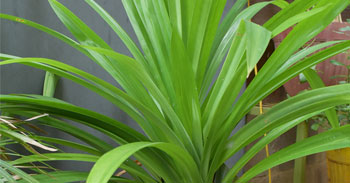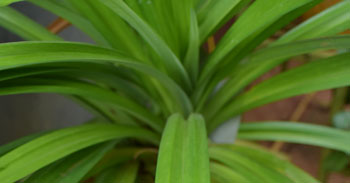KJC Medicinal Garden
-
Pandanus amaryllifolius
Order: Pandanales
Family: pandanaceae
Genus: pandanus
Species: P. amaeryllifolius
Common Names: Pandan, Fragrant Pandan, Scented Pandan, Screwpine, Fragrant Screwpine, Indonesian Screwpine, Pandan Rampeh, Pandan Wangi, Daun Pandan
Native to Southeast Asia Indonesia, Sri Lanka, and West New Guinea.
Other plants of the same genus with medicinal properties
-
-no content-
- Shrub(11.6 m tall) or small tree (2 – 4.5 m tall) depending on culture.
- Tree form has an Erect trunk(15cm wide) which produces thick aerial roots.
- Leaves of the tree form are the same shape, but about twice the size (7 - 9 cm wide, 150 - 220 cm long) , Leaves are spirally arranged.
- Flowers: only male flowers are found which also very rare it has spike of flowers with a white spathe.
- No production of fruits due to lack of female inflorescences.
Uses in Tradition systems of medicine
- Pandan acts as pain relief, especially arthritis and joint pain.
- Pandan can also help ease headaches and earachers.
- LEAVES
-
1. The juice of leaves and inflorescence is used to treat chest pains, reduce fevers, and inflammation from arthritis in humans as well as in animals.
2. The juice of leaves and inflorescence is used to treat chest pains, reduce fevers, and inflammation from arthritis in humans as well as in animals.
3. Infusions of the leaves are used internally and externally as a sedative against restlessness.
4. Chewing the leaf of Pandanus odoratissimus maintains oral health and stops bleeding gums.
5. The leaves are also used to ease stomach cramps and spasms, and are given to women recovering after childbirth.
6. Extracts of the leaves can be added to bath water for skin problems and relief from sunburn.
- ROOTS
-
1. The root of Pandanus amaryllifolius boiled in milk can cure female sterility and can prevent a miscarriage.
2. The root is used traditionally to treat STD’s, namely, syphilis.
- Beta-carotene.
- Vitamin C
- Thiamin
- Riboflavin
- Niacin
- 100 g Pandanus paste provides 321 kilocalories, 2.2 g protein, 134 mg calcium, 108 mg phosphorus, 5.7 mg iron, 0.04 mg thiamin, 2 mg vitamin C [14–16], and from 390 to 724 μg/100 g beta-caroten.
Suggested Medicinal Properties
- Anti-convulsant
- Anti-oxidative
- Anti-viralA
- Anti-diabetic
- Anti-inflammatory
- Neuroprotective Activity
- Analgesic Activity
- Antitumour Activity
- Nocturnal Enuresis
- Anti-microbial
- Anti-diuretic activity
- CNS Depressant activity
Active Phytochemicals
1. Over time, research has shown that Pandanus amaryllifolius Roxb. is rich in a wide range of compounds, of which several have pharmacological potential.
2. As reported histochemical and preliminary phytochemical screening provides the general idea regarding the presence of primary and secondary metabolites revealed the presence of phytoconstituents such as alkaloids, terpenoids, flavonoids, saponins, anthraquinone glycoside and cardiac glycoside
3. It is also mentioned that carbohydrate, tannins, flavonoids and saponins are present in the ethanolic extract of Pandanus amaryllifolius.
4. A previously conducted study showed that compounds like flavonoids and saponins might be responsible for the antidiabetic activity
5. Pandan leaf extract contains the free amino acids and reducing sugars such as glutamic acid, proline, glucose, and fructose as possible precursors to ACPY (2-acetyl-1-pyrroline) and might play significant role in the aroma ACPY formation.
6. The major volatile compound in heated pandan and unheated pandan are 3-methyl-2(5H)-furanone followed by ACPY and 3-Methyl- 2(5H)-furanone respectively.
7. They also found that ACPY is the only compound that possessed pandan aroma characteristic by using GCO (gas chromatography-olfactometry) analysis .
8. The presence of 2AP(2-Acetyl- 1-Pyrroline) was also determined using GCMS by using ethanol as the solvent to extract 2AP from Pandan leaves and the higher 2AP peak arises from ethanol chromatogram
9. Additionally 30 aroma components also have been found of which the main ones are hexanal, 2-hexenal, 3-methyl pyridine, 2-penten-1-ol, nonanal, benzaldehyde and linalool .
10. In the study, suggested that pandan extracts showed good potential of bioactive compounds such as catechin, gallic acid, kaempferol and naringin. Pandan leaves contains Gallic acid, catechin, caffeic acid, myricetin, luteolin, and quercetin.
11. It is also reported that Pandanin, (mannose-binding protein) appears to be present in the saline leaf extract in minute amount elicits antiviral activity.
12. Pandan leaves contain certain alkaloids like Norpandamarilactonine-A,-B, Pandamarilactam 3x,-3y, Pandamarilactone-1, Pandamarilactonine A,-B,-C, Pandamarine, Pandanamine.
13. The other alkaloids (such as, pandanamine, pandamerilactones) with pyrroline-derived structures are also found in the leaves.
14. In-depth phytochemical analysis has confirmed the presence of several compounds such as essential oils, tocopherols, tocotrienols, alkaloid, fatty acids, esters non‐specific lipid transfer protein, carotenoids and flavonoids that act as a natural antioxidant and antidiabetic agents.
15. PA leaf extract demonstrated higher antioxidant activity than that of root extract. The major flavonoid in plant is quercetin, which belongs to a flavonol class that could inhibit α‐glucosidase enzyme by acting as a noncompetitive inhibitor.

References
Bhuyan B and Sonowal R: An overview of Pandanus amaryllifolius Roxb.exLindl. and its potential impact on health, Curr Trends Pharm Res, 2021; 8 (1): 138-157
Tafesse TB, Hymete A, Mekonnen Y, Tadesse M. Antidiabetic activity and phytochemical screening of extracts of the leaves of Ajuga remota Benth on alloxan-induced diabetic mice. BMC Complementary and Alternative Medicine ,2017. Vol 17:243 ,DOI 10.1186/s12906-017-1757-5

